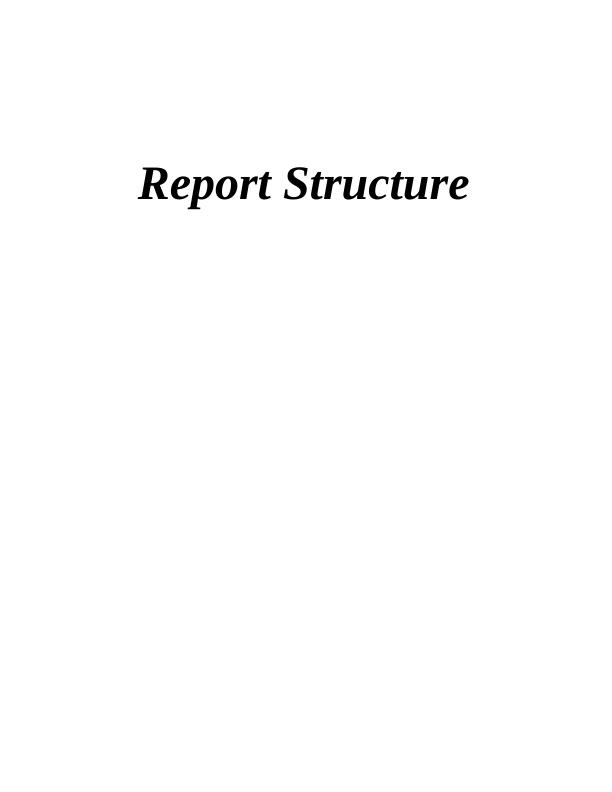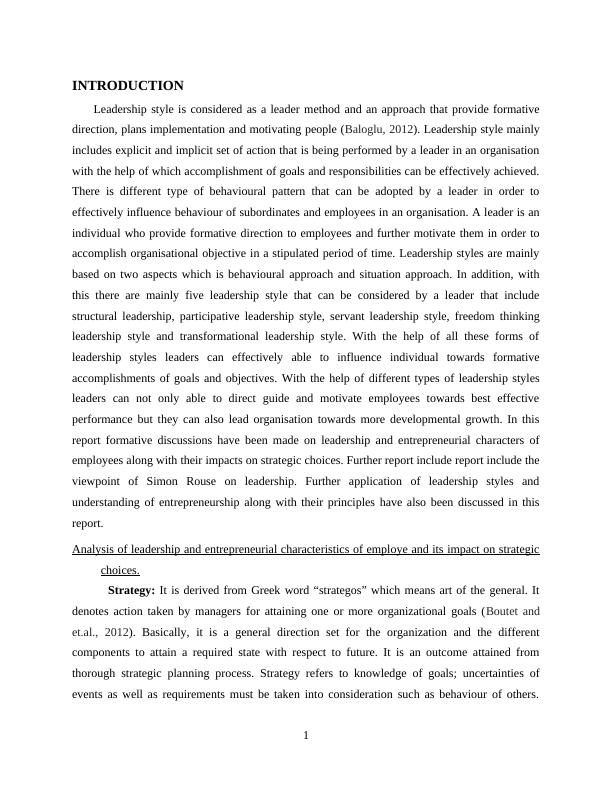(PDF) Entrepreneurial leadership
Added on 2021-02-20
12 Pages4650 Words54 Views
Report Structure

Table of ContentsINTRODUCTION...........................................................................................................................1Analysis of leadership and entrepreneurial characteristics of employe and its impact onstrategic choices...........................................................................................................................1Critically evaluate how these characteristics might enhance or inhibit growth and/or change inthis organisation...........................................................................................................................4Reflection on applications of own learning, knowledge and career aspirations..........................7CONCLUSION................................................................................................................................8REFERENCES................................................................................................................................9

INTRODUCTIONLeadership style is considered as a leader method and an approach that provide formativedirection, plans implementation and motivating people (Baloglu, 2012). Leadership style mainlyincludes explicit and implicit set of action that is being performed by a leader in an organisationwith the help of which accomplishment of goals and responsibilities can be effectively achieved.There is different type of behavioural pattern that can be adopted by a leader in order toeffectively influence behaviour of subordinates and employees in an organisation. A leader is anindividual who provide formative direction to employees and further motivate them in order toaccomplish organisational objective in a stipulated period of time. Leadership styles are mainlybased on two aspects which is behavioural approach and situation approach. In addition, withthis there are mainly five leadership style that can be considered by a leader that includestructural leadership, participative leadership style, servant leadership style, freedom thinkingleadership style and transformational leadership style. With the help of all these forms ofleadership styles leaders can effectively able to influence individual towards formativeaccomplishments of goals and objectives. With the help of different types of leadership stylesleaders can not only able to direct guide and motivate employees towards best effectiveperformance but they can also lead organisation towards more developmental growth. In thisreport formative discussions have been made on leadership and entrepreneurial characters ofemployees along with their impacts on strategic choices. Further report include report include theviewpoint of Simon Rouse on leadership. Further application of leadership styles andunderstanding of entrepreneurship along with their principles have also been discussed in thisreport.Analysis of leadership and entrepreneurial characteristics of employe and its impact on strategicchoices.Strategy: It is derived from Greek word “strategos” which means art of the general. Itdenotes action taken by managers for attaining one or more organizational goals (Boutet andet.al., 2012). Basically, it is a general direction set for the organization and the differentcomponents to attain a required state with respect to future. It is an outcome attained fromthorough strategic planning process. Strategy refers to knowledge of goals; uncertainties ofevents as well as requirements must be taken into consideration such as behaviour of others.1

Generally, strategy denotes a blueprint of decisions within organization which reflects their goalsand objectives, plan for attaining these goals. As per Simon Rouse strategy is important aswithout effectual foresight, organization might not be ready to foresee the uncertain events whichcomprises of business environment. It is a roadmap which defines overall vision, mission anddirection for an organization. Strategy provides a bridge between where the organization is atpresent scenario and where they want to be.Understanding of strategy: As per Simon Rouse Managing Director of PeoplePlusUK,strategy deals with integration of organisational activities, as well as utilisation and allocation ofscarce resources in an organisational environment to meet the objectives at prevailing situation.It is necessary that while planning the decisions must be taken in such a form that reactions ofpeople who are affected by that like employees, suppliers or competitors must be taken intoconsideration (By, Burnes and Oswick, 2012). Strategies must be created in such a manner thatthey deal with long term developments rather than day to day operations. Generally, it includesprobability of innovations of new methods or products or developing within a new market infuture. Simon says that strategies are created to understand the behaviour of competitors as wellas customers. In other words, it is prediction with respect to market. If strategies are formulatedfor employees then it denotes that behaviour of employees will be predicted with respect tofuture aspects. Its objective is to maximise strengths of organisation and reduce the strengths oftheir competitors. Leadership: It denotes ability of a group or an individual to create an impact and guidethe employees of an organization (Cameron and Green, 2015). This is an art of motivatingcertain group of people who aims at attaining a common goal. As per Simon it means thatdirecting other members and colleagues with a strategy to accomplish organizational goals.Leadership comprises of formulation effective as well as clear vision, communicating same withothers so that they can acknowledge what is required to be done and furnishing methods,knowledge and information to realize vision. Along with this, it also comprises of coordinationand balance in between conflict interest of all stakeholders. Leader is an individual who steps inif some critical situation arises to handle that in creative manner. According to Simon,transactional leadership is only suitable in case of short term situations in which to be on track isvery important. On the other hand transformational leadership is major style which leads2

End of preview
Want to access all the pages? Upload your documents or become a member.
Related Documents
Entrepreneurship and Leadership of Business Ventureslg...
|8
|2048
|192
Impact of Leadership Styles on Organizational Performancelg...
|27
|8157
|297
Impact of Leadership Styles on Strategic Management: A Case Study of Photoshop Worldwidelg...
|12
|4094
|421
Management and Leadership Perspectiveslg...
|10
|2654
|66
What recent academic studies say about leadershiplg...
|7
|1932
|42
The Concept Of Leadership Management Essaylg...
|7
|2715
|624
